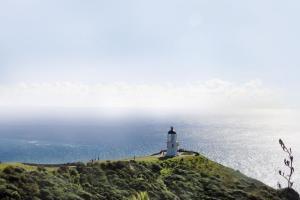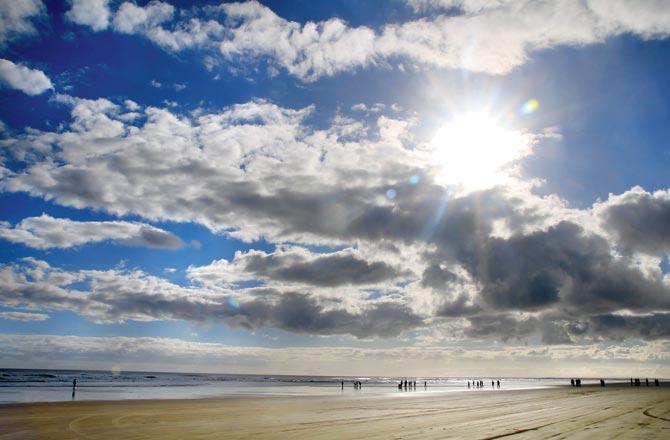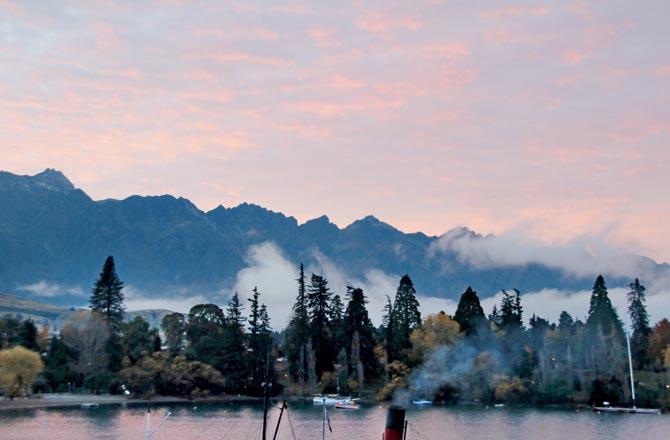Meet 2,000-year-old Tane Mahuta, who helped life flourish on Earth; that and other stories await in the Maori past

Cape Reinga, the northern most tip of the Northland and a day-long drive from Bay of Islands, is where the Tasman Sea and Pacific Ocean meet
For centuries, the creation story has thrived despite its plurality. Christianity tells us how god made the universe in six days, Hinduism, which doesn't follow a single view on evolution, draws from the myth of Brahma emerging from an egg. There is also naturalist Charles Darwin's theory of complex life evolving from simplistic ancestors. Three weeks ago, we welcomed one more story to this growing repository, under a canopy of overgrown, ageing trees, nearly 12,000 km from home, in the Waipoua Kauri Forest of Northland, New Zealand.
We were here to meet 2,000-year-old Tane Mahuta, the Lord of the Forests, of whom we had heard so much by the third day of our stay in Northland that when Charles Naera, our local guide, led us to this imperial tree, it was impossible to not be in awe. Standing at 51.5m, with a trunk girth of 13.8m, this ancient kauri (agathis australis) tree, native to the country, has also been given the title of the separator of heaven and earth.
ADVERTISEMENT

The Ninety Mile Beach in Northland, which is actually just 55 miles (88 km) long. Pics/Jane Borges
As the Maoris — the indigenous tribe of New Zealand — will tell you, the love between Ranginui 'Sky Father' and Papatuanuku 'Earth Mother' was so immense that they refused to be released from each other's embrace; in the process, they kept their six children from the light. This, until one of them, Tane Mahuta, "lay on his back and dug his shoulders deep into his mother's body", forcing Ranginui to the heavens and flooding the world with light, air and space, and allowing life to flourish. In New Zealand, every nook and cranny has been built on such Maori legends. Its people, birds, forests, lakes and mountains are all co-conspirators in the story of its making.
Legends from the north
The day we took our flight to Auckland (via Singapore), Mumbai was a shining 33 degrees Celsius. Fifteen hours later, we were layered for 16 degrees. May is the ideal time to visit New Zealand, because it is still transitioning from autumn to winter. This also means that its lush, emerald valleys, which you saw play out on cinematic scale as Middle Earth in The Lord of The Rings, make way for shades of auburn, rust, and mustard. And, it's prettier than it sounds.

Queenstown in May glows in shades of autumn
On our eight-day itinerary was the Bay of Islands, an enclave comprising 40 islands, Northland, and a trip to Queenstown and Doubtful Sound in Southland. After a brief layover in Auckland, where we enjoyed dinner on a vessel that sailed around the harbour, offering us a distant, but impressive view of the city by night, we flew to the Bay of Islands.
Our arrival, however, was marked with trepidation. Because, no sooner had we landed at the Bay of Islands' Kerikeri airport, we were driven to the base from where we were to fly on a light aircraft and jump off 9,000 feet from the sky, albeit tandem. It reads like cakewalk, but skydiving can be a daunting proposition, especially for the mind. My tandem instructor, Michael Pemberton at Skydive Bay of Islands, though, was cool as cucumber, and so, strapped to him, my fall felt like a breeze.

The cruise ship sailing across Doubtful Sound
The high of this adventure took a backseat, when the history lessons followed at the Waitangi Treaty Grounds. Also called the birthplace of the nation, this is where the Treaty of Waitangi was first signed on February 6, 1840, between the British Crown and MÄÂu00c2u0081ori chiefs, paving the way for an amicable resolution to the bitter civil clashes that had lasted decades. Before the Europeans expanded their colonial interests here in the 17th century, this place was occupied for nearly 500 years by the indigenous Maoris, settlers from eastern Polynesia, who arrived by sea in their canoes, inhabiting land previously only home to native birds and trees.
The Museum of Waitangi, officially named Te Konngahu, meaning unborn child in Maori — a metaphor for the promised nation — puts the conflict between the colonised and colonisers into perspective, with portrait-sized pictures of the key heroes of this treaty, their contributions, facsimiles of the documents, weaponry and artefacts that hark back to the event, and a video recreation, too. It's here that we were exposed to the Maori way of life, with a brief cultural performance by the locals.

The 2,000-year-old Tane Mahuta
For the Kiwis, their land is so deeply enmeshed in its legends that it becomes hard to separate this myth from reality. Science is only for those who crave logic. Otherwise, life revolves around the gods and the ghosts. At Cape Reinga, the northernmost tip of Northland and a day-long drive from Bay of Islands, we witnessed the beginning of the end of the Maori life.
Home to an ancient pohutukawa tree (metrosideros excelsa) and a solitary lighthouse, Cape Reinga, which separates the Tasman Sea and Pacific Ocean, is where Maori spirits are said to descend into the underworld by sliding down the roots of the tree into the sea below. From here, they climb out onto Oahu, the highest point of the islands, and say their final farewell before going back to the land of their ancestors, Hawaiki-A-Nui. Two days later, when we arrived in Queenstown, which sits on the shores of Lake Wakatipu in Southland, the spirit stories made way for the romantic.

The tram ride around Canterbury, Christchurch
Of birds, seals and dolphins
As we soaked in the expansive views of Lake Wakatipu and the gargantuan snow-clad Southern Alps from inside a cable car lift (gondola) — the steepest in the Southern Hemisphere — our host, Kylie Hall, mentioned how the lake owed its existence to a Maori Romeo. The cast of this story includes star-crossed lovers, Manata and Matakauri, who lived in a village in the area.
An alliance between the two was impossible, as Manata was the daughter of the chief, and Matakauri, a commoner. But when Manata gets kidnapped by a giant taniwha named Matau, Matakauri's brave rescue makes him the only worthy partner for the young princess.

Bird's eye view of Doubtful Sound from Wilmot Pass
Later, to prevent any trouble for his new wife, Matakauri is said to have gone back to the mountains where the giant lived and set a great fire around him. The taniwha's body burned so long that it created a trough hundreds of metres deep and 75 km long. The rains eventually filled this valley, giving it its name, Wakatipu, the trough of the giant. Hall, a gifted storyteller like most Kiwis, had us convinced. We were in the land of the burnt giant.
Our stay at Queenstown was a brief one, but it's here that autumn really opened up to us. The small tourist town, for most, was lined with red maple trees, and the ducks and seagulls on the lakefront were picture-postcard perfect. But, the best part of this cold clime travel was the overnight cruise in the wilderness of Doubtful Sound, a fjord in Fiordland National Park.

Early morning view in Queenstown, Southland
The twisting inlets created by the melting of glaciers, offers a spectacular scape of peaks, blanketed with rainforests and natural waterfalls. The trip, organised by Real Journeys, to the UNESCO World Heritage Site involved changing many modes of transport. We began with a bus drive to Te Anau from Queenstown, followed by a short cruise across the misty Lake Manapouri and another drive across the dense rainforest at Wilmot Pass, before arriving at Deep Cove.
Here, we were acquainted with another Maori legend of how the god Tu-Te-Raki-Whanoa, who wanted to provide refuge from the stormy seas nearby, created the fjord by splitting a rock with his magical adze and carving out four arms. While our cruise sailed across all four of them — First Arm, Crooked Arm, Hall Arm and Deep Cove, the experience of witnessing the golden sunset at Tasman Sea was unparalleled. As the sun disappeared into the horizon, the cruise passed by a colony of fur seals who were lazing on a rock, indifferent to our cameras going clickety-clack at them. Being off the grid has its advantages, and that night, after we checked into our luxury rooms, we had to admit that the overwhelming silence ensured we tucked in early.

The sunset at Tasman Sea, during the cruise trip to Doubtful Sound
We did wake up to the sound of dolphins the next day. And, though the freezing temperatures outside made it difficult to hold our teeth together, it didn't stop us from enjoying their game of hide and seek. Before we left for Deep Cove, our captain suggested we keep our cameras and phones aside, and sit at the bow to listen to the sounds of the native birds. We have to confess that it was the best five minutes of our holiday in New Zealand.
Building again
The final leg of our journey was in Christchurch, which witnessed the horrifying mosque shootings only two months ago. This quaint city has a rustic, country feel, and is still picking up lost pieces — the city has been rebuilding itself after the last major earthquake in 2011 that killed nearly 185 people. While the city has emerged stronger one tragedy after another, the wounds are still visible, like the fractures that show on some of its un-mended, broken walls. But the floral wreaths that continue to line Hagley Park, in remembrance of the dead, is testimony to how people sometimes have to find strength in their own stories, even their legends, to prevail.

Graphic/Ravi Jadhav
Getting there:
Singapore Airlines operates 17 weekly flights from Mumbai to Singapore and 7 weekly onward flights from Singapore to Auckland and Christchurch.
Air New Zealand runs daily flights to Bay of Islands and Queenstown from Auckland.
Where to stay:
Auckland: Hilton Auckland is located within walking distance from the Sky Tower and some of the city's best nightlife spots
Bay of Islands: Copthorne Hotel and Resort is surrounded by nearly 60 acres of subtropical gardens. The Waitangi Treaty Grounds is nearby
Queenstown: Crowne Plaza offers views of Lake Wakatipu and the surrounding mountains, and is located in the heart of the town
Christchurch: The five-star George Hotel overlooks Hagley Park and the Avon River
Things to do at Christchurch
Visit the International Antarctic Centre: Experience what it is like to be caught in an Antarctic storm, at temperatures of below -8 degree Celsius
Punting on Avon: Spend half-an-hour punting down the Avon River in central Christchurch with a trained punter steering the boat
Tram tour: Get a ride around the city, on one of the restored heritage trams
Walk at Hagley Park: Enjoy and evening walk around the park
Catch up on all the latest Mumbai news, crime news, current affairs, and also a complete guide on Mumbai from food to things to do and events across the city here. Also download the new mid-day Android and iOS apps to get latest updates
 Subscribe today by clicking the link and stay updated with the latest news!" Click here!
Subscribe today by clicking the link and stay updated with the latest news!" Click here!







